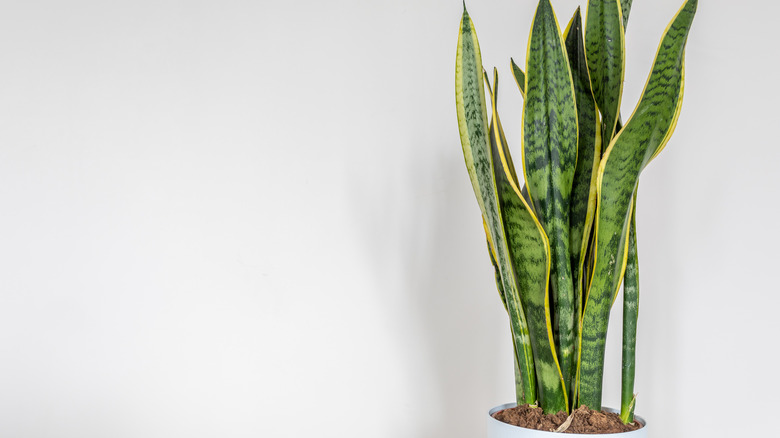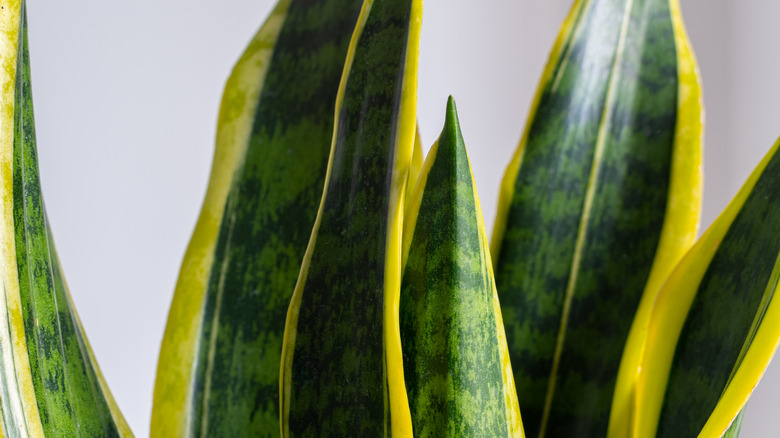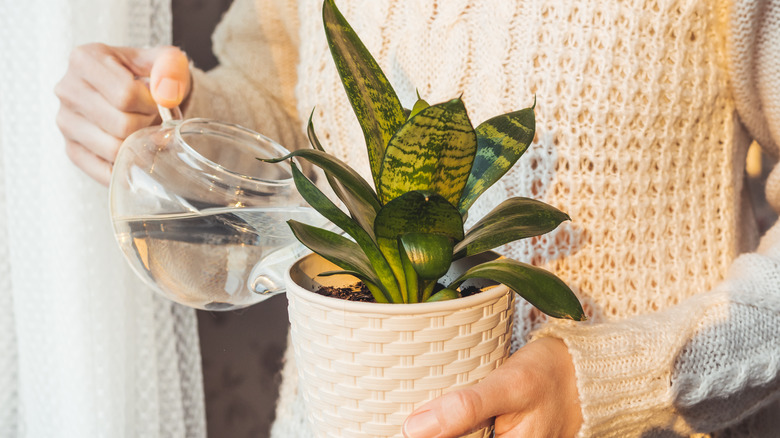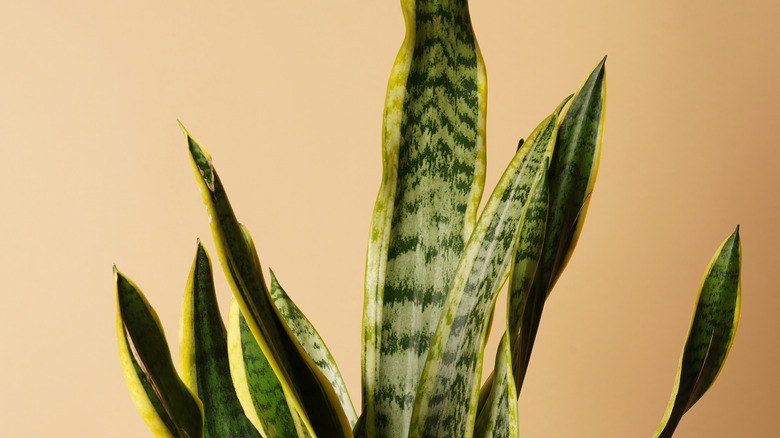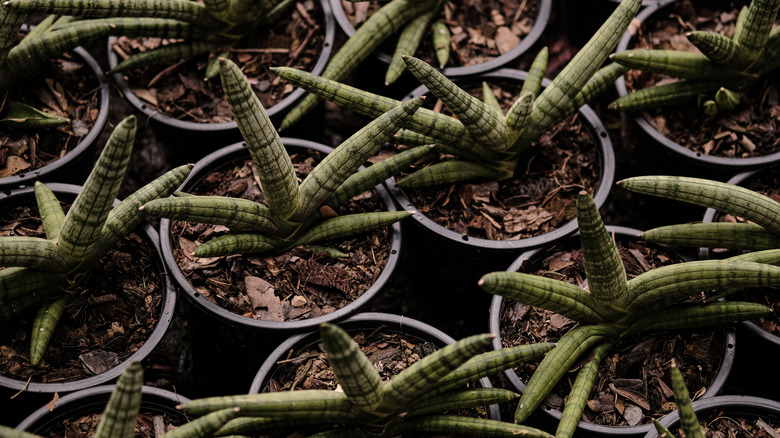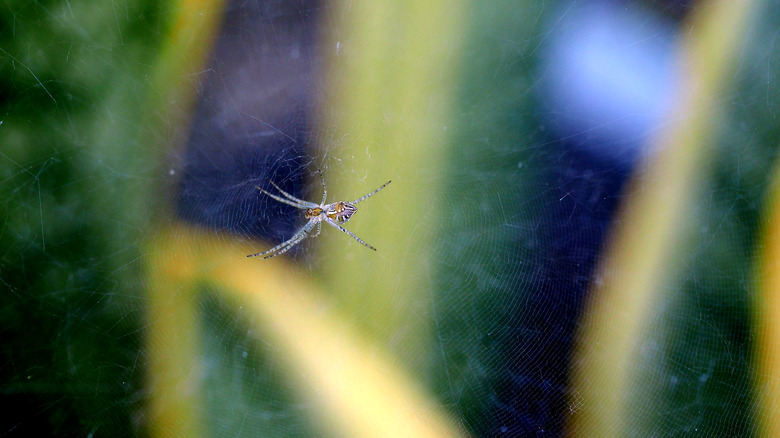Telltale Signs Your Snake Plants Are In Trouble
In case you haven't noticed, houseplants are having a major moment. After COVID-19 forced us all to spend an extended period of time at home, purchasing houseplants became the norm for bringing the outdoors indoors (via NBC News). According to The Spruce, one of the most popular (and easiest) houseplants on the market is the sansevieria, most commonly referred to as the snake plant given its tall, straight leaves. There are a wide variety of sansevieria, ranging in size, shape, and color, but the care is virtually the same for all of them.
Snake plants are known for being some of the easiest to care for and most resilient houseplants out there, only needing water about once a month or up to once a season, and they can thrive in relatively low light environments (via The Spruce). Still, not everyone has a seasoned green thumb, so it's definitely helpful to equip yourself with the knowledge of when your snake plant might be in distress.
Abnormally yellow leaves
Yellow leaves are typically the universal sign that a plant is not doing well. It should be noted that some varieties of snake plants have a bright yellow border around the leaves (via The Spruce), which is totally normal. But leaves that are becoming entirely yellow or feature a dull, mustard-yellow color are signs of trouble. Keeping an eye out for yellow leaves (and some additional factors) can help you recognize when it's time to step in and save your snake plant.
The biggest and most common problem when it comes to caring for snake plants and signs that they are struggling is overwatering (via Bloomscape), which results in yellow leaves. Snake plants do not need frequent waterings, and therefore, plant owners can sometimes get carried away showing too much love to their green friends! Your best bet is to water when the top half of the soil is completely dry, and to be sure that you're watering on a pretty regular schedule. Leaving the soil completely dry for a while and then soaking it with water can definitely stress out your snake plant.
Wrinkly or curled leaves
While snake plants are one of the most resilient varieties of plants, the fact that they can still visibly show signs of distress is a helpful characteristic in determining their care. Case in point: wrinkling or curling leaves (also referred to as "blades" by Bloomscape).
Unlike the common issue of overwatering and the telltale signs that coincide with it, blades that are curling or wrinkling can actually be a sign of under-watering. That is, either going too long in-between waterings or not providing enough water when you do.
Bloomscape suggested figuring out a regular watering schedule when the upper part of the soil surrounding your plant is totally dry. If your snake plant is currently super dry from top to bottom, it's time to get that baby in the sink or tub, and actually soak it! Just be sure to either have a pot with proper drainage, or if you don't, be careful about how much water you use to soak your plant. You don't want to go from under-watered to overwatered.
Brown leaf tips
Another sign of trouble with your snake plant is the appearance of brown tips on the leaves. Typically, if there are any brown areas on your snake plant's leaves, it will be at the very tips or tops of your snake plant blades. Again, while overwatering is a very common cause for snake plant distress, brown tips can be prominent signs of under-watering in addition to a multitude of other factors. According to Smart Garden Guide, brown tips on snake plant leaves can also be signs of over-chlorinated or otherwise tainted water, low humidity or cold sensitivity, or too much sunlight. If you weren't already aware, you should know that plants can burn in sunlight that is too bright or direct! While snake plants can grow in a variety of light from low to high and generally grow better in brighter light environments, too much light can cause them to burn and crisp (via HGTV).
Leaves that are wilting or falling over
You might suddenly see that one or more of your snake plant's leaves are starting to droop, wilt, or bend, which can be another sign of trouble. Wilting leaves can certainly be a sign of overwatering and root rot, as the roots and leaves can be holding more water than they can handle (via Gardening Know How).
However, drooping or wilting leaves can also be a sign that your snake plant needs more light. Snake plants are often coveted because they can grow in lower-light environments. But they are still plants and require a little bit of sunlight in order to grow! So putting your snake plant in a spot that gets virtually no light may result in wilting leaves, which is your snake plant telling you it needs more sunlight to recover (via Gardening Know How). Additionally, drooping leaves can be another sign of too much sunlight, if placed in an area that gets intense, direct sunlight, and can also be the result of incorrect repotting.
Signs of pests
Finally, one of the biggest issues for all houseplants — with snake plants being no exception — is the intrusion of pests. Pests can be identified on plants' leaves or atop their soil, sometimes as bugs that you see moving about, other times as white, web-like clusters. No matter what, realizing your snake plant has pests is a sign to take immediate action.
While some pests will attack any houseplant they can find, you might be surprised to know that some pests are really attracted to snake plants. According to Simply Plants, the pests that seriously love your snake plant include spider mites, scales, aphids, whiteflies, and gnats. Generally, pests can be eradicated easily with neem oil or neem-based repellent, as well as certain DIY pest repellents that are available online. Your best bet is to try to avoid getting pests in the first place, though. You can do this by monitoring your watering so as not to overwater your snake plant, as this can lead to root rot and excessive moisture, which is a perfect breeding ground for pests and mold. Too much humidity can also be a playground for pests, as can poor air circulation.
Keep a regular eye on your snake plant to make sure you don't see anything out of the ordinary, and it should be happy leaves from there on out!
